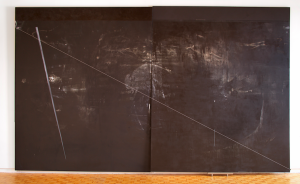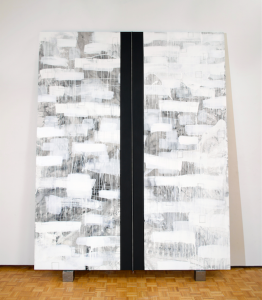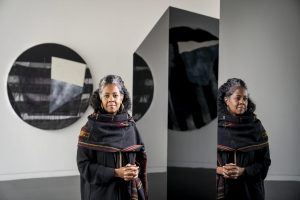
Torkwase Dyson with her installation Nautical Dusk, 2018. Photo by Gabe Souza, Courtesy of the Colby Museum of Art and Lunder Institute
Torkwase Dyson employs abstract shapes and forms as a means of exploring the intersections of environmental liberation, movement, and architecture. Within her work, she has developed a unique vocabulary of abstract lines, forms, shapes, and edges informed by her own evolving theory of Black Compositional Thought. This working term considers how waterways, architecture, objects, and geographies are composed and inhabited by black bodies, and how the properties of energy, space, and scale can form networks of liberation.
Produced for the New Orleans Museum of Art, Torkwase Dyson: Black Compositional Thought | 15 Paintings for the Plantationocene, a solo exhibition on view through April 19, 2020, features fifteen paintings about composition. These works are inspired by the design systems of architecture, water infrastructure, the oil and gas industry, and the physical impact of global warming. The exhibition also examines the legacy of plantation economies and their relationship to the environmental and infrastructural issues of our current age, which many characterize as the “plantationocene.” Injecting these spatial constructions with a sense of precarity and emancipatory possibility, Dyson asserts new perspectives on geography, imagination, and belonging. As she states: “Environmental liberation is an ongoing practice, and, as a painter, I’m committed to a language of shape that thinks of our work as spatial and haunting; liquid and mountains; bird and lava. And in this moment of climate change, I am certain that the beauty in black world-building will continue to be guided by the poetry of our own hands. So as an artist, I am committed to praising black spatial genius through my work.”
Dyson was born in Chicago and spent her developmental years between North Carolina and Mississippi. Traversing these regions helped develop a fundamental sensitivity towards urban development, southern landscape and black spatial justice. During her years at Tougaloo College where she majored in Sociology and double minored in Social Work and Fine Art, she began to examine the spatial dynamics of black history and how these histories where connected geographically. For ten years, Dyson traveled to Africa and South and Central America to strategize with communities of color on ways to attain resource equality. During this time she earned her Bachelors in Fine Arts in Painting from Virginia Commonwealth University and her Masters in Fine Arts in Painting from Yale School of Art. In 2016, she designed and built Studio South Zero (SSZ), a solar-powered mobile studio where the context of nomadicity became the framework for learning and making art about the environment. It was traveling with SSZ that inspired her experimental project The Wynter-Wells Drawing School for Environmental Liberation, where she explores contemporary theorizations of space, architecture and the infrastructure of extraction economies.
Dyson draws a connection between the abstract forms of her art, and the networks of industrialized white supremacist power that shape our political landscape: histories of spatial segregation, policing, and vagrancy laws, and other “exclusions of subjectivity” that often hide in the abstractions of machines, maps, and data. Her practice takes up abstraction as a tool for reshaping our current political landscape, and reimagining these systems from within. As she has written, “I am interested in how the illusion of space pushes up against real space on a two-dimensional surface … and how the compression of the two produces something indeterminate, modular, poetic, haptic, and unsteady.”
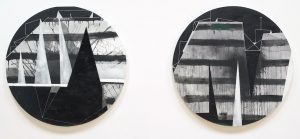
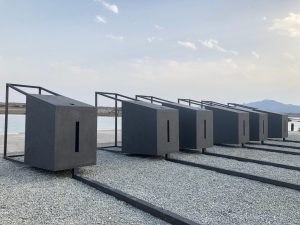
NOMA members inspire the love of art in every visitor who walks into the Great Hall or through the gates of the Sydney and Walda Besthoff Sculpture Garden.
In addition to enjoying benefits like special members’ previews of exhibitions, free wellness classes surrounded by sculptures, and a complimentary subscription to NOMA Magazine, our members enable schoolchildren to discover the Old Masters, community members to engage with world-class art and local artists, and NOMA’s curators to present innovative and provocative exhibitions year after year.
JOIN TODAY
